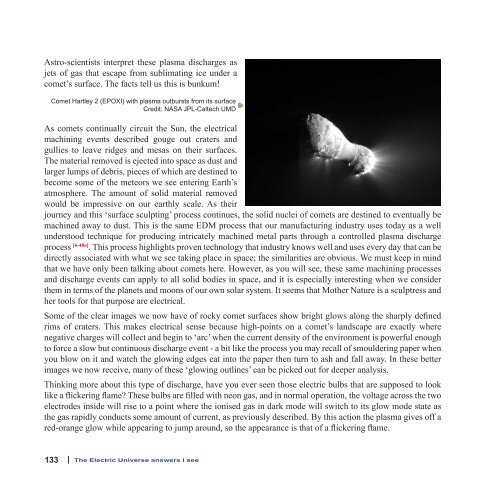A Beginner's View of Our Electric Universe - New
A Beginner's View of Our Electric Universe - New
A Beginner's View of Our Electric Universe - New
Create successful ePaper yourself
Turn your PDF publications into a flip-book with our unique Google optimized e-Paper software.
Astro-scientists interpret these plasma discharges as<br />
jets <strong>of</strong> gas that escape from sublimating ice under a<br />
comet’s surface. The facts tell us this is bunkum!<br />
Comet Hartley 2 (EPOXI) with plasma outbursts from its surface<br />
Credit: NASA JPL-Caltech UMD<br />
As comets continually circuit the Sun, the electrical<br />
machining events described gouge out craters and<br />
gullies to leave ridges and mesas on their surfaces.<br />
The material removed is ejected into space as dust and<br />
larger lumps <strong>of</strong> debris, pieces <strong>of</strong> which are destined to<br />
become some <strong>of</strong> the meteors we see entering Earth’s<br />
atmosphere. The amount <strong>of</strong> solid material removed<br />
would be impressive on our earthly scale. As their<br />
journey and this ‘surface sculpting’ process continues, the solid nuclei <strong>of</strong> comets are destined to eventually be<br />
machined away to dust. This is the same EDM process that our manufacturing industry uses today as a well<br />
understood technique for producing intricately machined metal parts through a controlled plasma discharge<br />
process [6-48b] . This process highlights proven technology that industry knows well and uses every day that can be<br />
directly associated with what we see taking place in space; the similarities are obvious. We must keep in mind<br />
that we have only been talking about comets here. However, as you will see, these same machining processes<br />
and discharge events can apply to all solid bodies in space, and it is especially interesting when we consider<br />
them in terms <strong>of</strong> the planets and moons <strong>of</strong> our own solar system. It seems that Mother Nature is a sculptress and<br />
her tools for that purpose are electrical.<br />
Some <strong>of</strong> the clear images we now have <strong>of</strong> rocky comet surfaces show bright glows along the sharply defined<br />
rims <strong>of</strong> craters. This makes electrical sense because high-points on a comet’s landscape are exactly where<br />
negative charges will collect and begin to ‘arc’ when the current density <strong>of</strong> the environment is powerful enough<br />
to force a slow but continuous discharge event - a bit like the process you may recall <strong>of</strong> smouldering paper when<br />
you blow on it and watch the glowing edges eat into the paper then turn to ash and fall away. In these better<br />
images we now receive, many <strong>of</strong> these ‘glowing outlines’ can be picked out for deeper analysis.<br />
Thinking more about this type <strong>of</strong> discharge, have you ever seen those electric bulbs that are supposed to look<br />
like a flickering flame? These bulbs are filled with neon gas, and in normal operation, the voltage across the two<br />
electrodes inside will rise to a point where the ionised gas in dark mode will switch to its glow mode state as<br />
the gas rapidly conducts some amount <strong>of</strong> current, as previously described. By this action the plasma gives <strong>of</strong>f a<br />
red-orange glow while appearing to jump around, so the appearance is that <strong>of</strong> a flickering flame.<br />
133 | The <strong>Electric</strong> <strong>Universe</strong> answers I see


